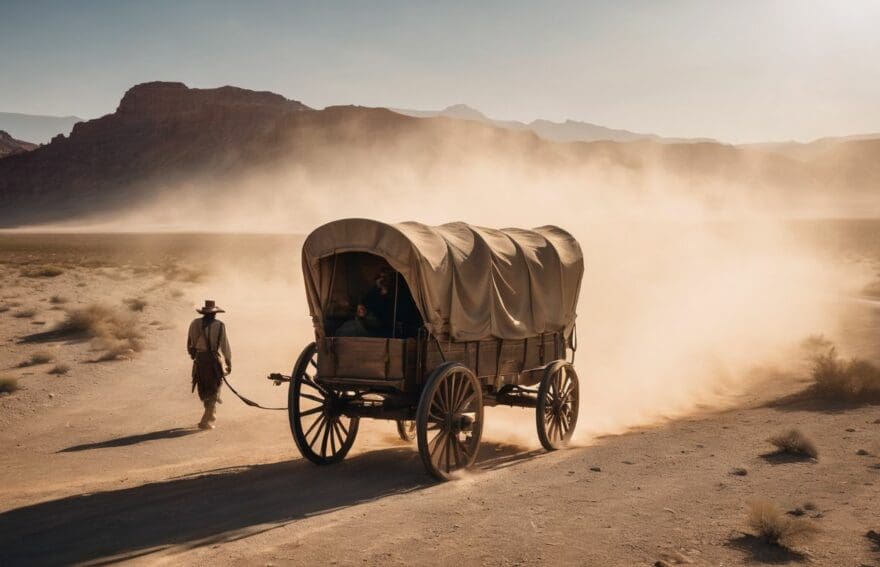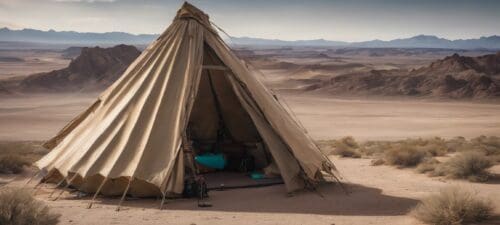Heat: Survival and Expansion in the American Frontier

Updated On: November 22, 2025 by 
Enduring the blistering heat whilst venturing into uncharted lands presented a formidable challenge for early settlers. We, too, have borne witness to the sheer intensity of historical extremes and appreciate that delving into yesteryear uncovers stories of grit and inventiveness.
Our chronicle will guide you through the incendiary hardships to the creative advancements on America’s pioneering frontier. Learn how sweltering trials tempered a nation’s mettle – your journey through history begins here!
Western Frontier Life in America
The American west was known for its harsh weather conditions, including extreme heat and droughts, making survival a constant struggle. These environmental challenges also had a profound impact on the Native American cultures of the region.
Harsh weather conditions
We face scorching heatwaves, bone-chilling winters, and everything in between as we step into the boots of pioneers on the American frontier. Harsh weather is a relentless foe out here, pushing human resilience to its limits.
Settlers forge ahead through blistering sun and relentless droughts, knowing that the baking earth beneath their feet can become a frozen wasteland without warning.
Our survival hinges on adapting quickly to these extreme elements. Sweltering summers turn prairie grass golden while icy blasts make frontiersmen yearn for shelter against snowstorms that can sweep across the Great Plains with little notice.
Adobe homes offer some respite from the heat in southwestern territories while sod houses provide insulation during cold snaps up north – innovations born out of necessity and resourcefulness amid unpredictable and harsh weather conditions.
Impact on Native American cultures
The harsh weather conditions of the American frontier significantly impacted Native American cultures. Many indigenous tribes depended on hunting, gathering, and agriculture for sustenance.
However, extreme heat and unpredictable weather patterns caused disruption to their traditional way of life. Native Americans were forced to adapt their hunting and farming practices as well as migration patterns in response to the challenges posed by the harsh climate.
Furthermore, the expansion of European settlers onto Native American lands had a profound impact on their cultures. The clash of these two distinct cultures brought about conflict, displacement, and loss of ancestral territories for many indigenous peoples.
The Heat Death of the American Frontier
Devastating extreme heat caused widespread destruction and transformation of the American frontier, leading to significant changes in agricultural history and the way of life for settlers.
This period marked a turning point that required innovative strategies to adapt and survive in the harsh conditions of the western frontier.
Devastation caused by extreme heat
Extreme heat on the American frontier caused devastating effects as settlers struggled to endure the scorching temperatures. Crops withered, livestock perished, and water sources dried up, leading to food shortages and economic hardship for many pioneering families.
The relentless heat also took a toll on physical health, resulting in sunstroke and dehydration among those trying to carve out a living in the harsh wilderness. In addition, extreme heat made construction of homes challenging due to materials deteriorating quickly in such conditions.
These hardships forced pioneers to adapt quickly and find innovative ways to survive in an unforgiving environment.
Taking into account these challenges related to extreme heat is essential for understanding the ingenuity and determination that characterised life on the frontier during this period of expansion.
Transformation of agricultural history
Settlers in the American frontier faced a significant shift in agricultural history following the 1887 blizzard. The “Great Die Up” led to widespread devastation of cattle and livestock, prompting pioneers to diversify their farming methods.
This event marked a turning point as settlers adapted by focusing on crops like wheat, corn, and oats that could withstand extreme weather conditions while also investing in irrigation systems to mitigate the impact of future natural disasters.
As more people moved westward after the Civil War, they encountered diverse challenges and employed innovative agricultural techniques to adapt to the harsh environment. This transformation laid the groundwork for modern agriculture in America’s western frontier, shaping not only survival strategies but also influencing economic growth and settlement patterns during this period.
Preparing for Westward Expansion
To prepare for the challenges of westward expansion, settlers constructed cheap homes using materials like sod, adobe, or timber. These homes were designed to withstand extreme heat and harsh weather conditions along the frontier trails.
Construction of cheap homes
Pioneers in the American frontier built cheap homes to quickly establish settlements, often using materials like turf, adobe, or timber. These humble constructions were essential for survival but deteriorated within 5 to 8 years due to harsh weather and lack of maintenance.
Settlers on the Great Plains made turf homes from large blocks of grass and dirt, while those in the southwest utilised adobe bricks resembling Native American dwellings. The construction of these simple homes reflects the resourcefulness and adaptability required for survival in the wild west.
The challenges faced during westward migration didn’t deter settlers from finding innovative ways to build temporary shelters and form new communities, paving the way for further expansion into uncharted territories.
Challenges faced during westward migration
Following the construction of cheap homes for westward expansion, settlers encountered several challenges during their migration. These challenges included:
- Hostile Native American tribes defending their land, resulting in violent clashes and skirmishes.
- Limited water sources along the trails leading to dehydration and difficulties sustaining life and agriculture.
- Treacherous terrain, including steep mountains, thick forests, and dangerous rivers, making travel slow and hazardous.
- Threats from wildlife such as bears, wolves, and snakes posed danger to both humans and livestock.
- Severe weather conditions like extreme heat, blizzards, and tornadoes added additional hardships to the already arduous journey.
- Lack of transport infrastructure led to rough trails and inadequate roads that made it hard for wagons or animals to traverse.
The 1887 Blizzard: A Turning Point
The 1887 Blizzard, also known as the “Great Die Up,” was a significant turning point in American frontier history. This devastating blizzard had a profound impact on agriculture and further shaped the challenges faced by those living on the frontier.
The “Great Die Up”
The 1887 blizzard, known as the “Great Die Up,” had a profound impact on the American frontier. The harsh winter weather took a toll on cattle and wildlife, resulting in significant losses for ranchers and farmers.
This event led to a transformation in agricultural history, forcing settlers to adapt their farming practices to survive in the unforgiving environment of the frontier.
As pioneers navigated the challenges of westward expansion, they were confronted with extreme weather conditions that tested their resilience and resourcefulness. The devastating effects of the “Great Die Up” prompted settlers to reevaluate their approach to agriculture and livestock management, shaping the way communities adapted and thrived in this rugged terrain.
Impact on agriculture
The “Great Die Up” had a profound impact on agriculture in the American frontier. The blizzard wiped out thousands of cattle, leading to a significant decline in livestock numbers.
This event also prompted changes in ranching practices, with many ranchers diversifying their operations and introducing new techniques to protect against future disasters.
Pioneers faced additional challenges due to the extreme weather conditions, such as droughts and harsh winters, which affected crop production. Despite these difficulties, settlers adapted by experimenting with different farming methods and utilising irrigation systems to sustain their agricultural efforts.
Frontier Culture: Rugged Individualism
The influence of the frontier on American culture can still be seen today, with the persistence of rugged individualism and self-reliance as enduring values. This mentality was shaped by the challenges faced in the harsh conditions of the American frontier, leading to a culture that valued independence and resilience.
Influence of the frontier on American culture
The frontier had a profound influence on American culture, shaping the development of rugged individualism. Settlers in the Old West relied on their resourcefulness and self-sufficiency to survive in harsh conditions.
This ingrained sense of independence became a defining trait of American identity, celebrated in folklore and popular culture as the essence of the pioneering spirit.
Pioneers’ experiences living off the land and building new communities also contributed to an enduring appreciation for resilience and determination. The Wild West’s legacy lives on through stories of cowboys, homesteading, and westward expansion, showcasing how the frontier not only shaped history but also left an indelible mark on American values and attitudes towards perseverance.
Persistence of rugged individualism
The American frontier greatly influenced the culture of the United States, giving rise to the concept of rugged individualism. This spirit emphasised independence, self-reliance, and resilience in facing challenges.
Pioneers on the Western frontier had to rely on their own skills and resourcefulness to survive in a harsh environment, leading them to cultivate an ethos of individual strength that has endured through generations.
Frontier individuals were characterised by their ability to overcome adversity without relying on external support or assistance. They demonstrated exceptional adaptability and determination while navigating the challenges posed by rough terrain, extreme weather conditions, and limited resources.
Conclusion
In conclusion, life on the American frontier was tough due to extreme heat and harsh weather conditions. Settlers had to adapt quickly by building cheap homes and relying on their resourcefulness to survive.
The 1887 blizzard proved to be a turning point in shaping America’s agricultural history and the culture of rugged individualism that persisted in the frontier.
FAQs
1. What was the journey like on the westward expansion trails?
The trek on the westward expansion trails was tough and demanding, with pioneers travelling in Conestoga wagons and facing many challenges as they pursued their Manifest Destiny across the American Frontier.
2. Why did people move to the frontier towns during the Gold Rush?
People were drawn to frontier towns during the Gold Rush because they hoped to find fortune and new opportunities, which were central motivations for Western migration under the belief in Manifest Destiny.
3. How did settlers survive in the harsh conditions of the American Frontier?
Settlers learnt to adapt by farming, building shelters from available materials, and forming close-knit communities for support while expanding into what they believed was their destined land conquest.
4. What role did Manifest Destiny play in America’s westward expansion?
Manifest Destiny drove Americans with a sense of purpose towards western territories; it justified their Westward migration and motivated them to expand territory despite hardships.









